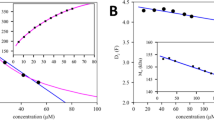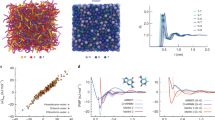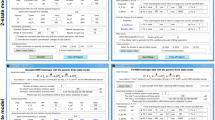Abstract
Cooperativity, a universal property of biological macromolecules, is typically characterized by a Hill slope, which can provide fundamental information about binding sites and interactions. We demonstrate, through simulations and single-molecule FRET (smFRET) experiments, that molecular heterogeneity lowers bulk cooperativity from the intrinsic value for the individual molecules. As heterogeneity is common in smFRET experiments, appreciation of its influence on fundamental measures of cooperativity is critical for deriving accurate molecular models.
This is a preview of subscription content, access via your institution
Access options
Subscribe to this journal
Receive 12 print issues and online access
$189.00 per year
only $15.75 per issue
Buy this article
- Purchase on Springer Link
- Instant access to full article PDF
Prices may be subject to local taxes which are calculated during checkout



Similar content being viewed by others
References
De Meyts, P., Roth, J., Neville, D.M., Gavin, J.R. & Lesniak, M.A. Biochem. Biophys. Res. Commun. 55, 154–161 (1973).
Levitzki, A. & Koshland, D.E. Proc. Natl. Acad. Sci. USA 62, 1121–1128 (1969).
Lohman, T.M. & Ferrari, M.E. Annu. Rev. Biochem. 63, 527–570 (1994).
Perutz, M.F. Q. Rev. Biophys. 22, 139–237 (1989).
Hill, A.V. J. Phys. 40, iv–vii (1910).
Weiss, J.N. FASEB J. 11, 835–841 (1997).
Wyman, J. Adv. Protein Chem. 19, 223–286 (1964).
Lu, H.P., Xun, L.Y. & Xie, X.S. Science 282, 1877–1882 (1998).
Zhuang, X. et al. Science 296, 1473–1476 (2002).
Okumus, B., Wilson, T.J., Lilley, D.M.J. & Ha, T. Biophys. J. 87, 2798–2806 (2004).
Qu, X.H. et al. Proc. Natl. Acad. Sci. USA 105, 6602–6607 (2008).
Solomatin, S.V., Greenfeld, M., Chu, S. & Herschlag, D. Nature 463, 681–684 (2010).
Sattin, B.D., Zhao, W., Travers, K., Chu, S. & Herschlag, D. J. Am. Chem. Soc. 130, 6085–6087 (2008).
Draper, D.E., Grilley, D. & Soto, A.M. Annu. Rev. Biophys. Biomol. Struct. 34, 221–243 (2005).
Draper, D.E. Biophys. J. 95, 5489–5495 (2008).
Das, R., Travers, K.J., Bai, Y. & Herschlag, D. J. Am. Chem. Soc. 127, 8272–8273 (2005).
Das, R. et al. J. Mol. Biol. 332, 311–319 (2003).
Greenfeld, M., Solomatin, S.V., Herschlag, D. J. Biol. Chem. doi:10.1074/jbc.M111.235465 (08 April 2011).
Bartley, L.E., Zhuang, X.W., Das, R., Chu, S. & Herschlag, D. J. Mol. Biol. 328, 1011–1026 (2003).
Tawfik, D.S. Nat. Chem. Biol. 6, 692–696 (2010).
Travers, K.J., Boyd, N. & Herschlag, D. RNA 13, 1205–1213 (2007).
Acknowledgements
We thank H. Mabuchi (Department of Applied Physics, Stanford University) for technical support and D. Pavlichin for helping to create data analysis software. This work was funded by the US National Institutes of Health through grant GM49243 to D.H.
Author information
Authors and Affiliations
Contributions
S.V.S., M.G. and D.H. contributed to the experimental design and writing of the manuscript; M.G. performed the experiments; and M.G. and S.V.S. carried out data analysis.
Corresponding author
Ethics declarations
Competing interests
The authors declare no competing financial interests.
Supplementary information
Supplementary Text and Figures
Supplementary Figures 1–3, Supplementary Methods and Supplementary Note (PDF 286 kb)
Rights and permissions
About this article
Cite this article
Solomatin, S., Greenfeld, M. & Herschlag, D. Implications of molecular heterogeneity for the cooperativity of biological macromolecules. Nat Struct Mol Biol 18, 732–734 (2011). https://doi.org/10.1038/nsmb.2052
Received:
Accepted:
Published:
Issue Date:
DOI: https://doi.org/10.1038/nsmb.2052
This article is cited by
-
Analysis of transient membrane protein interactions by single-molecule diffusional mobility shift assay
Experimental & Molecular Medicine (2021)
-
Local-to-global signal transduction at the core of a Mn2+ sensing riboswitch
Nature Communications (2019)
-
Complete integrability of information processing by biochemical reactions
Scientific Reports (2016)
-
Collective behaviours: from biochemical kinetics to electronic circuits
Scientific Reports (2013)
-
Ultraviolet Shadowing of RNA Can Cause Significant Chemical Damage in Seconds
Scientific Reports (2012)



